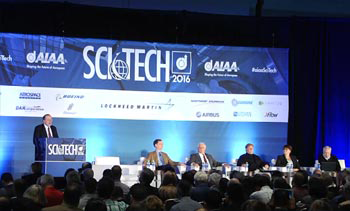U.S. Science and Technology Enterprise Requires Realignment to Current Strategic Threats Written 4 January 2016
Paenlists: Courtney Stadd, management advisor, Catalyst Partners LLC (moderator), Mark Albrecht, chairman of the board, US Space, LLC; Carissa Christensen, managing partner, The Tauri Group; Jacques Gansler, distinguished professor, University of Maryland; Daniel Goldin, chairman, president & CEO, Intellisis Corp.; and Timothy Persons, chief scientist, U.S. GAO.
by Lawrence Garrett, AIAA Web Editor

Panelists kicked off the 2016 AIAA Science and Technology Forum and Exposition in San Diego Jan. 4, 2016, with a discussion on the current state of U.S. aerospace science and technology policy and many of the associated challenges facing the new administration, as well as private industry, beginning in 2017.
Timothy Persons, chief scientist with the U.S. Government Accountability Office, pointed to a number of challenges, including the growing number of patents being created in Asia and Europe. Persons suggested that a U.S. science and technology reboot is needed and that it should focus on international “collaboration,” noting that in the past, agencies like NASA and the Department of Defense have had success accomplishing goals through international partnerships.
Persons also said that setting risk tolerance is very important.
“We have a lot of resistance to failure, particularly in our political circles — [and] that’s not what’s incentivized and rewarded, and yet failure is often a very good teacher,” he said. “There’s a need to incentivize manufacturing innovation.”
Jacques Gansler, a distinguished professor at the University of Maryland, said that to overcome the government’s cultural resistance to innovation, there must be a recognition for the need for change and leadership that wants to make such changes.
Gansler noted that every time there’s an example of waste, fraud and abuse, Congress passes another law that results in more regulations. He said the current code of federal regulation is now more than 280,000 pages and that the cost (to government and industry) is estimated to be more than $1.75 trillion. Gansler said it’s imperative that many of these regulations are removed.
Mark Albrecht, chairman of the board with U.S. Space LLC, said that one of the biggest challenges is “that very littlethat government S&T is working on is directly focused on technologies to meet critical requirements to service a strategic objective that is well-stated, clear and adequately resourced.”
He said that while there are wonderful activities happening in avionics, thermal and propulsion, they’re not focused on any strategic mission.
“In my time, I have never seen a dearth of a strategic overview for the United States national security and foreign policy in the 35 years I’ve been doing this,” Albrecht said. “I mean, you can’t really point to what our strategic objectives are.”
Looking ahead to the arrival of a new U.S. presidential administration in 2017, Albrecht said the big challenge will be to develop a strategic context for how the U.S. looks at its national security problem facing real threats.
Carissa Christensen, managing partner with The Tauri Group, said that she agrees that the federal research and development enterprise is underfunded and that the science and technology enterprise is not well-aligned with the current threat environment. She touched upon how industry has a key role in innovation, calling the American space industry an “S&T success story.”
“Behind that [success] are space companies and an investment community that are putting capital at risk,” Christensen said. “They’re innovating rapidly. They’re operating globally, not being driven by traditional space actors.”
She said that in many cases, these companies are moving at a faster pace, geared more toward Silicon Valley than to Washington, D.C., and more aligned with the world environment.
Daniel Goldin, chairman, president and CEO of Intellisis Corp., mentioned five key points for how U.S. science and technology should move forward.
He said that there has to be more responsibility and accountability; that America’s education programs need to improve; that no program should last more than two presidential terms unless it can show why it's in the national interest; that there needs to be increased competition; and, when referring to where additional needed science and technology funds could come from, that the U.S. should cancel 20 percent of the programs.
“They’re dead,” he said. “They don’t need to be there. We can’t have three and four decade programs for high profitability for their shareholders.”
